Traditional Agroforestry Systems and Conservation of Native Plant Diversity of Seasonally Dry Tropical Forests
Abstract
1. Introduction
2. Materials and Methods
2.1. Study Area
The Apancle: A Traditional Agroforestry System Associated with Tropical Dry Forest
2.2. Sampling Design
2.3. Data Analyses
3. Results
3.1. Types of Agroforestry Practices
3.2. Capacity for Biodiversity Conservation
3.3. Floristic Composition
3.4. Endemism
3.5. Reasons for Conserving the Native Vegetation
4. Discussion
4.1. Capacity for Biodiversity Conservation
4.2. Floristic Composition
4.3. Types of Agroforestry Practices Implemented in the Apancles
4.4. Implications of the Apancles for Conservation of Biocultural Diversity
4.5. Strategies and Perspectives for Public Policies
5. Conclusions
Supplementary Materials
Author Contributions
Funding
Acknowledgments
Conflicts of Interest
References
- Perfecto, I.; Vandermeer, J. Biodiversity Conservation in Tropical Agroecosystems. A New Conservation Paradigm. Ann. N. Y. Acad. Sci. 2008, 1134, 173–200. [Google Scholar] [CrossRef] [PubMed]
- Altieri, M.A.; Toledo, V.M. The agroecological revolution in Latin America: Rescuing nature, ensuring food sovereignty and empowering peasants. J. Peasant Stud. 2011, 38, 587–612. [Google Scholar] [CrossRef]
- Fischer, J.; Abson, D.J.; Butsic, V.; Chappell, M.J.; Ekroos, J.; Hanspach, J.; Kuemmerle, T.; Smith, H.G.; von Wehrden, H. Land sparing versus land sharing: Moving forward. Conserv. Lett. 2014, 7, 149–157. [Google Scholar] [CrossRef]
- Casas, A.; Camou, A.; Otero Arnaiz, A.; Rangel Landa, S.; Cruse-Sanders, J.; Solís, L.; Torres, I.; Delgado, A.; Moreno Calles, A.I.; Vallejo, M.; et al. Manejo tradicional de biodiversidad y ecosistemas en Mesoamérica: El Valle de Tehuacán. Investig. Ambient. 2014, 6, 23–44. [Google Scholar]
- Casas, A.; Caballero, J.; Mapes, C.; Zárate, S. Manejo de la vegetación, domesticación de plantas y origen de la agricultura en Mesoamérica. Bol. Soc. Bot. México 1997, 61, 31–47. [Google Scholar] [CrossRef]
- Moreno-Calles, A.I.; Galicia-Luna, V.; Casas, A.; Toledo, V.M.; Vallejo-Ramos, M.; Santos-Fita, D.; Amou-Guerrero, A. La Etnoagroforestería: El estudio de los sistemas agroforestales tradicionales de México. Etnobiología 2014, 12, 1–16. [Google Scholar]
- MacNeish, R.S. A summary of subsistence. In The Prehistory of the Tehuacán Valley: Enviroment and Subsistence; Byers, D.S., Ed.; University of Texas Press: Austin, TX, USA, 1967; pp. 209–309. [Google Scholar]
- Altieri, M.A.; Toledo, V.M. Natural resource management among small-scale farmers in semi-arid lands: Building on traditional knowledge and agroecology. Ann. Arid Zone 2005, 44, 365–385. [Google Scholar]
- Boege, E. El Patrimonio Biocultural de los Pueblos Indígenas de México. Hacia la Conservación in Situ de la Biodiversidad y Agrodiversidad en los Territorios Indígenas, 1st ed.; Instituto Nacional de Antropología e Historia: Ciudad de México, Mexico; Comisión Nacional Para el Desarrollo de los Pueblos Indígenas: Mexico City, Mexico, 2008; ISBN 9789680303854. [Google Scholar]
- Casas, A.; Lira, R.; Torres, I.; Delgado-Lemus, A.; Moreno-Calles, A.I.; Rangel-Landa, S.; Blancas, J.; Larios, C.; Solís, L.; Pérez-Negrón, E.; et al. Ethnobotany for Sustainable Ecosystem Management: A Regional Perspective in the Tehuacán Valley. In Ethnobotany of Mexico. Interactions of People and Plants in Mesoamerica; Lira, R., Casas, A., Blancas, J., Eds.; Springer: Utrecht, The Netherlands, 2016; pp. 179–206. ISBN 9781461466697. [Google Scholar]
- Leakey, R.R.B. The Role of Trees in Agroecology and Sustainable Agriculture in the Tropics. Annu. Rev. Phytopathol. 2014, 52, 113–133. [Google Scholar] [CrossRef]
- Bhagwat, S.A.; Willis, K.J.; Birks, H.J.B.; Whittaker, R.J. Agroforestry: A refuge for tropical biodiversity? Trends Ecol. Evol. 2008, 23, 261–267. [Google Scholar] [CrossRef]
- Noble, I.R.; Dirzo, R. Forests as Human-Dominated Ecosystems. Science 1997, 227, 522–525. [Google Scholar] [CrossRef]
- Vallejo, M.; Moreno-Calles, A.I.; Casas, A. TEK and biodiversity management in agroforestry systems of different sociocological contexts of the Tehuacán Valley. J. Ethnobiol. Ethnomed. 2016, 12, 31. [Google Scholar] [CrossRef] [PubMed]
- Moreno-Calles, A.I.; Casas, A.; Blancas, J.; Torres, I.; Masera, O.; Caballero, J.; García-Barrios, L.E.; Pérez-Negrón, E.; Rangel-Landa, S. Agroforestry systems and biodiversity conservation in arid zones: The case of the Tehuacán Valley, Central México. Agrofor. Syst. 2010, 80, 315–331. [Google Scholar] [CrossRef]
- Moreno-Calles, A.I.; García-Frapolli, E.; Casas, A.; Torres-García, I. Traditional agroforestry systems of multi-crop “milpa” and “chichipera” cactus forest in the arid Tehuacán Valley, Mexico: Their management and role in people’s subsistence. Agrofor. Syst. 2012, 84, 207–226. [Google Scholar] [CrossRef]
- Moreno-Calles, A.I.; Toledo, V.M.; Casas, A. La importancia biocultural de los sistemas agroforestales tradicionales de México. In Hacia un Modelo Intercultural de Sociedad del Conocimiento en México; Olive, L., Lazos-Ramírez, L., Eds.; Universidad Nacional Autónoma de México: Ciudad de México, Mexico, 2014; pp. 35–56. ISBN 9786070263002. [Google Scholar]
- Vallejo, M.; Casas, A.; Moreno-Calles, A.I.; Blancas, J. Los sistemas agroforestales del Valle de Tehuacán: Una perspectiva regional. In Etnoagroforestería en México; Moreno-Calles, A.I., Casas, A., Toledo, V.M., Vallejo, M., Eds.; Universidad Nacional Autónoma de México: Morelia, Mexico, 2016; pp. 192–216. [Google Scholar]
- Rzedowski, J. Vegetación de México; Limusa: Ciudad de México, Mexico, 1978; ISBN 9789681800024. [Google Scholar]
- Bastin, J.-F.; Berrahmouni, N.; Grainger, A.; Maniatis, D.; Mollicone, D. The extent of forest in dryland biomes. Science 2017, 356, 635–638. [Google Scholar] [CrossRef]
- Olson, D.M.; Dinerstein, E.; Wikramanayake, E.D.; Burgess, N.D.; Powell, G.V.N.; Underwood, E.C.; D’amico, J.A.; Itoua, I.; Strand, H.E.; Morrison, J.C.; et al. Terrestrial Ecoregions of the World: A New Map of Life on Earth. Bioscience 2001, 51, 933–938. [Google Scholar] [CrossRef]
- Challenger, A.; Soberón, J. 3. Los ecosistemas terrestres. In Capital Natural de México, Vol. I: Conocimiento Actual de la Biodiversidad; Sarukhán, J., Ed.; Comisión Nacional para el Conocimiento y Uso de la Biodiversidad: Mexico City, Mexico, 2008; pp. 87–108. ISBN 978-607-7607-02-1. [Google Scholar]
- Trejo, I. El clima de la selva baja caducifolia en México. Investig. Geográficas 1999, 39, 40–52. [Google Scholar]
- García, E. Modificaciones al Sistema de Clasificación Climática de Köppen (Para Adaptarlo a Las Condiciones de la República Mexicana), 5th ed.; Instituto de Geografía, Universidad Nacional Autónoma de México: Ciudad de México, Mexico, 2004. [Google Scholar]
- Banda, K.; Delgado-Salinas, A.; Dexter, K.G.; Linares-Palomino, R.; Oliveira-Filho, A.; Prado, D.; Pullan, M.; Quintana, C.; Riina, R.; Rodríguez, G.M.; et al. Plant diversity patterns in neotropical dry forests and their conservation implications. Science 2016, 353, 1383–1388. [Google Scholar]
- Murphy, P.G.; Lugo, A.E. Ecology of Tropical Dry Forest. Annu. Rev. Ecol. Syst. 1986, 17, 67–88. [Google Scholar] [CrossRef]
- Búrquez, A.; Martínez-Yrízar, A. Límites geográficos entre selvas secas y matorrales espinosos y xerófilos: ¿qué conservar? In Diversidad, Amenazas y Áreas Prioritarias Para la Conservación de las Selvas Secas del Pacífico de México; Ceballos, G., Martínez, L., García, A., Espinoza, E., Bezaury Creel, J., Dirzo, R., Eds.; Fondo de Cultura Económica y Comisión Nacional para el Conocimiento y Uso de la Biodiversidad: Mexico City, Mexico, 2009; pp. 53–62. ISBN 9709000381. [Google Scholar]
- Janzen, D.H. Tropical dry forests: The most endangered major tropical ecosystem. In Biodiversity; Wilson, E.O., Peters, F.M., Eds.; National Academy Press: Washington, DC, USA, 1988; pp. 130–137. [Google Scholar]
- Trejo, I.; Dirzo, R. Deforestation of seasonally dry tropical forest: A national and local analysis in Mexico. Biol. Conserv. 2000, 94, 133–142. [Google Scholar] [CrossRef]
- Sánchez-Azofeifa, G.A.; Quesada, M.; Cuevas-Reyes, P.; Castillo, A.; Sánchez-Montoya, G. Land cover and conservation in the area of influence of the Chamela-Cuixmala Biosphere Reserve, Mexico. For. Ecol. Manag. 2009, 258, 907–912. [Google Scholar] [CrossRef]
- Miles, L.; Newton, A.C.; DeFries, R.S.; Ravilious, C.; May, I.; Blyth, S.; Kapos, V.; Gordon, J.E. A global overview of the conservation status of tropical dry forests. J. Biogeogr. 2006, 33, 491–505. [Google Scholar] [CrossRef]
- Montes-Londoño, I. Tropical Dry Forests in Multi-functional Landscapes: Agroforestry Systems for Conservation and Livelihoods. In Integrating Landscapes: Agroforestry for Biodiversity Conservation and Food Sovereignty; Montagnini, F., Ed.; Springer: Cham, Switzerland, 2017; pp. 47–78. [Google Scholar]
- Ribeiro, E.M.S. Efeitos da Pertubações Antrópicas Crônicas Sobre a Diversidade da Flora Lenhosa da Caatinga; Universidade Federal de Pernambuco: Recife, Brazil, 2015. [Google Scholar]
- Sánchez-Azofeifa, G.A. Research priorities for Neotropical dry forests. Biotropica 2005, 37, 477–485. [Google Scholar]
- Challenger, A. Utilización y Conservación de Los Ecosistemas Terrestres de México: Pasado, Presente y Futuro; Comisión Nacional para el Conocimiento y Uso de la Biodiversidad, Universidad Nacional Autónoma de México y Agrupación Sierra Madre, S.C.: Ciudad de México, Mexico, 1998; ISBN 9789709000023. [Google Scholar]
- Rzedowski, J. El endemismo en la flora fanerogámica mexicana: Una apreciación analítica preliminar. Acta Botánica Mex. 1991, 15, 47–64. [Google Scholar] [CrossRef]
- Olson, D.M.; Dinerstein, E. The Global 200: Priority Ecoregions for Global Conservation. Ann. Mo. Bot. Gard. 2002, 89, 199–224. [Google Scholar] [CrossRef]
- Vallejo, M.; Casas, A.; Pérez-Negrón, E.; Moreno-Calles, A.I.; Hernández-Ordoñez, O.; Tellez, O.; Dávila, P. Agroforestry systems of the lowland alluvial valleys of the Tehuacán-Cuicatlán Biosphere Reserve: An evaluation of their biocultural capacity. J. Ethnobiol. Ethnomed. 2015, 11, 8. [Google Scholar] [CrossRef]
- Vallejo, M.; Casas, A.; Blancas, J.; Moreno-Calles, A.I.; Solís, L.; Rangel-Landa, S.; Dávila, P.; Téllez, O. Agroforestry systems in the highlands of the Tehuacán Valley, Mexico: Indigenous cultures and biodiversity conservation. Agrofor. Syst. 2014, 88, 125–140. [Google Scholar] [CrossRef]
- Campos-Salas, N.; Casas, A.; Moreno-Calles, A.I.; Vallejo, M. Plant Management in Agroforestry Systems of Rosetophyllous Forests in the Tehuacán Valley, Mexico. Econ. Bot. 2016, 70, 254–269. [Google Scholar] [CrossRef]
- Smith, E.C. Plant remains. In The Prehistory of the Tehuacan Valley; MacNeish, R., Ed.; The Prehistory of the Tehuacan Valley: Austin, TX, USA, 1976; pp. 220–225. [Google Scholar]
- Blancas, J.; Casas, A.; Pérez-Salicrup, D.; Caballero, J.; Vega, E. Ecological and socio-cultural factors influencing plant management in Náhuatl communities of the Tehuacán Valley, Mexico. J. Ethnobiol. Ethnomed. 2013, 9, 39. [Google Scholar] [CrossRef]
- Smith, E.J. Agriculture, Tehuacan Valley. Fieldiana Bot. 1965, 31, 53–98. [Google Scholar]
- Casas, A.; Otero Arnaiz, A.; Pérez-Negrón, E.; Valiente-Banuet, A. In situ Management and Domestication of Plants in Mesoamerica. Ann. Bot. 2007, 100, 1101–1115. [Google Scholar] [CrossRef]
- Brunel, M.C. Poner la conservación al servicio de la producción campesina, reto para la construcción de un nuevo paradigma de desarrollo. Argumentos 2008, 57, 115–137. [Google Scholar]
- Blancas, J.; Casas, A.; Rangel-Landa, S.; Moreno-Calles, A.; Torres, I.; Pérez-Negrón, E.; Solís, L.; Delgado-Lemus, A.; Parra, F.; Arellanes, Y.; et al. Plant Management in the Tehuacán-Cuicatlán Valley, Mexico. Econ. Bot. 2010, 64, 287–302. [Google Scholar] [CrossRef]
- Rojas-Rabiela, T.; Martínez-Ruiz, J.L.; Murillo-Licea, D. Cultura Hidráulica y Simbolismo Mesoamericano del Agua; Rojas-Rabiela, T., Martínez-Ruiz, J.L., Murillo-Licea, D., Eds.; Instituto Mexicano de Tecnología del Agua (IMTA)/Centro de Investigaciones y Estudios Superiores en Antropología Social (CIESAS): Jiutepec, Mexico, 2009; ISBN 978-697-7563-06-8. [Google Scholar]
- Nair, P.K.R. Classification of agroforestry systems. Agrofor. Syst. 1985, 3, 97–128. [Google Scholar] [CrossRef]
- Casas, A.; Rangel-Landa, S.; Torres, I.; Peréz-Negrón, E.; Solís, L.; Parra, F.; Delgado, A.; Blancas, J.; Farfán-Heredia, B.; Moreno-Calles, A.I. In situ management and conservation of plant resources in the Tehuacán-Cuicatlán Valley, México: An ethnobotanical and ecological approach. In Current Topics in Ethnobotany; De Albuquerque, U.P., Alves-Ramos, M., Eds.; Research Signpost: Kerala, India, 2008; pp. 1–25. ISBN 9788130802435. [Google Scholar]
- Blancas, J.; Casas, A.; Moreno-Calles, A.I.; Caballero, J. Cultural Motives of Plant Management and Domestication. In Ethnobotany of Mexico. Interactions of People and Plants in Mesoamerica; Lira, R., Casas, A., Blancas, J., Eds.; Springer: Utrecht, The Netherlands, 2016; pp. 233–255. ISBN 978-1-4614-6668-0. [Google Scholar]
- Thiers, B. Index Herbariorum: A Global Directory of Public Herbaria and Associated Staff. New York Botanical Garden’s Virtual Herbarium. Available online: Sweetgum.nybg.org/ih/ (accessed on 3 December 2019).
- Díaz, S.; Pascual, U.; Stenseke, M.; Martín-López, B.; Watson, R.T.; Molnár, Z.; Hill, R.; Chan, K.M.A.; Baste, I.A.; Brauman, K.A.; et al. Assessing nature’s contributions to people. Science 2018, 359, 270–272. [Google Scholar] [CrossRef] [PubMed]
- Whittaker, R.H. Vegetation of the Siskiyou Mountains, Oregon and California. Ecol. Monogr. 1960, 30, 279–338. [Google Scholar] [CrossRef]
- Koleff, P.; Gaston, K.J.; Lennon, J.J. Measuring beta diversity for presence-absence data. J. Anim. Ecol. 2003, 72, 367–382. [Google Scholar] [CrossRef]
- Baselga, A. Partitioning the turnover and nestedness components of beta diversity. Glob. Ecol. Biogeogr. 2010, 19, 134–143. [Google Scholar] [CrossRef]
- Jost, L. Entropy and diversity. Oikos 2006, 113, 363–375. [Google Scholar] [CrossRef]
- Jost, L.; González-Oreja, J.A. Midiendo la diversidad biológica: Más allá del índice de Shannon. Acta Zoológica Lilloana 2012, 56, 3–14. [Google Scholar]
- Moreno, C.E.; Barragán, F.; Pineda, E.; Pavón, N.P. Reanálisis de la diversidad alfa: Alternativas para interpretar y comparar información sobre comunidades ecológicas. Rev. Mex. Biodivers. 2011, 82, 1249–1261. [Google Scholar] [CrossRef]
- Jost, L. The relation between evenness and diversity. Diversity 2010, 2, 207–232. [Google Scholar] [CrossRef]
- Marcon, E.; Hérault, B. entropart: An R Package to Measure and Partition Diversity. J. Stat. Softw. 2015, 67, 1–26. [Google Scholar] [CrossRef]
- Torres-García, I.; Rendón-Sandoval, F.J.; Blancas, J.; Casas, A.; Moreno-Calles, I. The genus Agave in agroforestry systems of Mexico. Bot. Sci. 2019, 97, 263–290. [Google Scholar] [CrossRef]
- Medina-Lemos, R. Achatocarpaceae. In Flora del Valle de Tehuacán-Cuicatlán; Medina-Lemos, R., Ed.; Instituto de Biología, Universidad Nacional Autónoma de México: Ciudad de México, Mexico, 2009; pp. 1–5. ISBN 9786070206399. [Google Scholar]
- García-Mendoza, A.J.; Franco Martínez, I.S.; Sandoval Gutiérrez, D. Cuatro especies nuevas de Agave (Asparagaceae, Agavoideae) del sur de México. Acta Bot. Mex. 2019, e1461. [Google Scholar] [CrossRef]
- Arias, S.; Gama-López, S.; Guzmán-Cru, L.U.; Vázquez-Benítez, B. Cactaceae. In Flora del Valle de Tehuacán-Cuicatlán; Medina-Lemos, R., Ed.; Instituto de Biología, Universidad Nacional Autónoma de México: Ciudad de México, Mexico, 2012; Volume 95, pp. 1–235. ISBN 9786070230790. [Google Scholar]
- Miguel-Talonia, C.; Téllez-Valdés, O.; Murguía-Romero, M. Las cactáceas del Valle de Tehuacán-Cuicatlán, México: Estimación de la calidad del muestreo. Rev. Mex. Biodivers. 2014, 85, 436–444. [Google Scholar] [CrossRef]
- Espejo-Serna, A. El endemismo en las Liliopsida mexicanas. Acta Bot. Mex. 2012, 100, 195–257. [Google Scholar] [CrossRef]
- International Union for Conservation of Nature (IUCN). The IUCN Red List of Threatened Species. Version 2019-3. Available online: https://www.iucnredlist.org/ (accessed on 20 May 2019).
- SEMARNAT. NOM-059-SEMARNAT, Protección Ambiental-Especies Nativas de México de Flora y Fauna Silvestre-Categorías de Riesgo y Especificaciones Para su Inclusión, Exclusión o Cambio-Lista de Especies en Riesgo; Secretariat of the Interior: Mexico City, Mexico, 2010; p. 77. [Google Scholar]
- The Convention on International Trade in Endangered Species of Wild Fauna and Flora (CITES). Apéndices I, II y III valid from 26 November 2019. Available online: https://www.cites.org (accessed on 17 March 2020).
- Marjokorpi, A.; Ruokolainen, K. The role of traditional forest gardens in the conservation of tree species in West Kalimantan, Indonesia. Biodivers. Conserv. 2003, 12, 799–822. [Google Scholar] [CrossRef]
- McNeely, J.A. Nature vs. nurture: Managing relationships between forests, agroforestry and wild biodiversity. Agrofor. Syst. 2014, 61, 155–165. [Google Scholar]
- Trejo, I.; Dirzo, R. Floristic diversity of Mexican seasonally dry tropical forests. Biodivers. Conserv. 2002, 11, 2063–2084. [Google Scholar] [CrossRef]
- Méndez-Toribio, M.; Martínez-Cruz, J.; Cortés-Flores, J.; Rendón-Sandoval, F.J.; Ibarra-Manríquez, G. Composición, estructura y diversidad de la comunidad arbórea del bosque tropical caducifolio en Tziritzícuaro, Depresión del Balsas, Michoacán, México. Rev. Mex. Biodivers. 2014, 85, 1117–1128. [Google Scholar] [CrossRef]
- Lott, E.J.; Bullock, S.H.; Solis-Magallanes, A. Floristic Diversity and Structure of Upland and Arroyo Forests of Coastal Jalisco. Biotropica 1987, 19, 228–235. [Google Scholar] [CrossRef]
- Gillespie, T.W.; Grijalva, A.; Farris, C.N. Diversity, composition, and structure of tropical dry forests in Central America. Plant Ecol. 2000, 147, 37–47. [Google Scholar] [CrossRef]
- Gallardo-Cruz, J.A.; Meave, J.A.; Pérez-García, E.A. Estructura, composición y diversidad de la selva baja caducifolia del Cerro Verde, Nizanda (Oaxaca), México. Bot. Sci. 2017, 35, 19–35. [Google Scholar] [CrossRef][Green Version]
- Rzedowski, J.; Calderón, G. Datos para la apreciación de la flora fanerogámica del bosque tropical caducifolio de méxico. Acta Bot. Mex. 2013, 102, 1–23. [Google Scholar] [CrossRef]
- Gentry, A.H. Diversity and floristic composition of neotropical dry forests. In Seasonally Dry Tropical Forests; Bullock, S.H., Mooney, H.A., Medina, E., Eds.; Cambridge University Press: Cambridge, UK, 1995; pp. 146–194. [Google Scholar]
- Valiente-Banuet, A.; Casas, A.; Alcántara, A.; Dávila, P.; Flores-Hernández, N.; del Coro Arizmendi, M.; Villaseñor, J.L.; Ortega Ramirez, J. La vegetación del valle de Tehuacán-Cuicatlán. Boletín La Soc. Botánica México 2000, 67, 24–74. [Google Scholar] [CrossRef]
- Rzedowski, J.; Medina-Lemos, R.; Calderón de Rzedowski, G. Inventario del conocimiento taxonómico, así como de la diversidad y del endemismo regionales de las especies mexicanas de Bursera (Burseraceae). Acta Bot. Mex. 2005, 70, 85–111. [Google Scholar] [CrossRef]
- Casas, A.; Parra, F.; Aguirre-Dugua, X.; Rangel-Landa, S.; Blancas, J.; Vallejo, M.; Moreno-Calles, A.I.; Guillén, S.; Torres-García, I.; Delgado-Lemus, A.; et al. Manejo y domesticación de plantas en Mesoamérica. Una estrategia de investigación y estado del conocimiento sobre los recursos genéticos. In Domesticación en el Continente Americano. Volumen 2. Perspectivas de investigación y manejo sustentable de recursos genéticos en el Nuevo Mundo; Universidad Nacional Autónoma de México/Universidad Nacional Agraria La Molina/CONACYT: Morelia, México, 2017; pp. 69–102. ISBN 978-607-02-9334-4. [Google Scholar]
- Durand, L. La relación ambiente-cultura en antropología: Recuento y perspectivas. Nueva Antropol. 2002, 18, 169–184. [Google Scholar]
- SEMARNAT. Experiencias de Agroforestería en México, 1st ed.; Moreno-Calles, A.I., Ed.; Secretaría de Medio Ambiente y Recursos Naturales (SEMARNAT): Ciudad de México, Mexico, 2019; ISBN 9786076260562. [Google Scholar]
- Moreno-Calles, A.I.; Casas, A. Agroforestry Systems: Restoration of Semiarid Zones in the Tehuacán Valley, Central Mexico. Ecol. Restor. 2010, 28, 361–368. [Google Scholar] [CrossRef]
- García-Licona, J.B.; Maldonado-Torres, R.; Moreno-Calles, A.I.; Álvarez-Sánchez, M.E.; García-Chávez, J.; Casas, A. Ethnoagroforestry management and soil fertility in the semiarid Tehuacán Valley, México. Ethnobiol. Conserv. 2017, 6, 1–8. [Google Scholar] [CrossRef]
- Berkes, F.; Folke, C.; Gadgil, M. Traditional Ecological Knowledge, Biodiversity, Resilience and Sustainability. Biodivers. Conserv. 1994, 4, 269–287. [Google Scholar]
- Berkes, F.; Folke, C. Linking Social and Ecological Systems. Management Practices and Social Mechanisms for Building Resilience; Cambridge University Press: Cambridge, UK, 1998; ISBN 9780521591409. [Google Scholar]
- Pretty, J.; Adams, B.; Berkes, F.; Ferreira, S.; Athayde, D.; Dudley, N. The Intersections of Biological Diversity and Cultural Diversity: Towards Integration. Conserv. Soc. 2009, 7, 100–112. [Google Scholar]
- Leakey, R.R.B. Converting ‘trade-offs’ to ‘trade-ons’ for greatly enhanced food security in Africa: Multiple environmental, economic and social benefits from ‘socially modified crops’. Food Secur. 2018, 10, 505–524. [Google Scholar] [CrossRef]
- Leakey, R.R.B. From ethnobotany to mainstream agriculture: Socially modified Cinderella species capturing ‘trade-ons’ for ‘land maxing’. Planta 2019, 250, 949–970. [Google Scholar] [CrossRef] [PubMed]
- Toledo, V.M.; Barrera-Bassols, N. La Memoria Biocultural. La Importancia Ecológica de Las Sabidurías Tradicionales; Icaria Editorial: Barcelona, Spain, 2008; ISBN 9788498880014. [Google Scholar]
- Berkes, F.; Colding, J.; Folke, C. Rediscovery of traditional ecological knowledge as adaptive management. Ecol. Appl. 2000, 10, 1251–1262. [Google Scholar] [CrossRef]
- Waggoner, P.E. How much land can ten billion people spare for nature? Daedalus 1996, 125, 73–93. [Google Scholar]
- Borlaug, N. Feeding a Hungry world. Science 2007, 318, 359. [Google Scholar] [CrossRef]
- Phalan, B.; Onial, M.; Balmford, A.; Green, R.E. Reconciling Food Production and Biodiversity Conservation: Land Sharing and Land Sparing Compared. Science 2011, 333, 1289–1291. [Google Scholar] [CrossRef]
- Perfecto, I.; Vandermeer, J. Separación o integración para la conservación de biodiversidad: La ideología detrás del debate “land- sharing” frente a “land-sparing “. Ecosistemas 2012, 21, 180–191. [Google Scholar]
- Vandermeer, J.; Perfecto, I. The Future of Farming and Conservation. Science 2005, 308, 1257b–1258b. [Google Scholar] [CrossRef]
- Ortega-Álvarez, R.; Casas, A.; Figueroa, F.; Sánchez-González, L.A. Producir y conservar: Nuevos horizontes en torno a los modelos de integración y separación territorial. Soc. Y Ambiente 2018, 18, 11–44. [Google Scholar] [CrossRef]
- Moreno-Calles, A.I.; Toledo, V.M.; Casas, A. Los sistemas agroforestales tradicionales de México: Una aproximación biocultural. Bot. Sci. 2013, 91, 375–398. [Google Scholar] [CrossRef]
- Durand, L. Pensar positivo no basta. Actitudes en torno a la conservación en la Reserva de la Biosfera Sierra de Huautla, México. Interciencia 2010, 35, 430–436. [Google Scholar]
- Díaz, S.; Fargione, J.; Iii, F.S.C.; Tilman, D. Biodiversity Loss Threatens Human Well-Being. PLoS Biol. 2006, 4, 1300–1305. [Google Scholar]
- Srivastava, D.S.; Vellend, M. Biodiversity-ecosystem function research: Is it relevant to conservation? Annu. Rev. Ecol. Evol. Syst. 2005, 36, 267–294. [Google Scholar] [CrossRef]
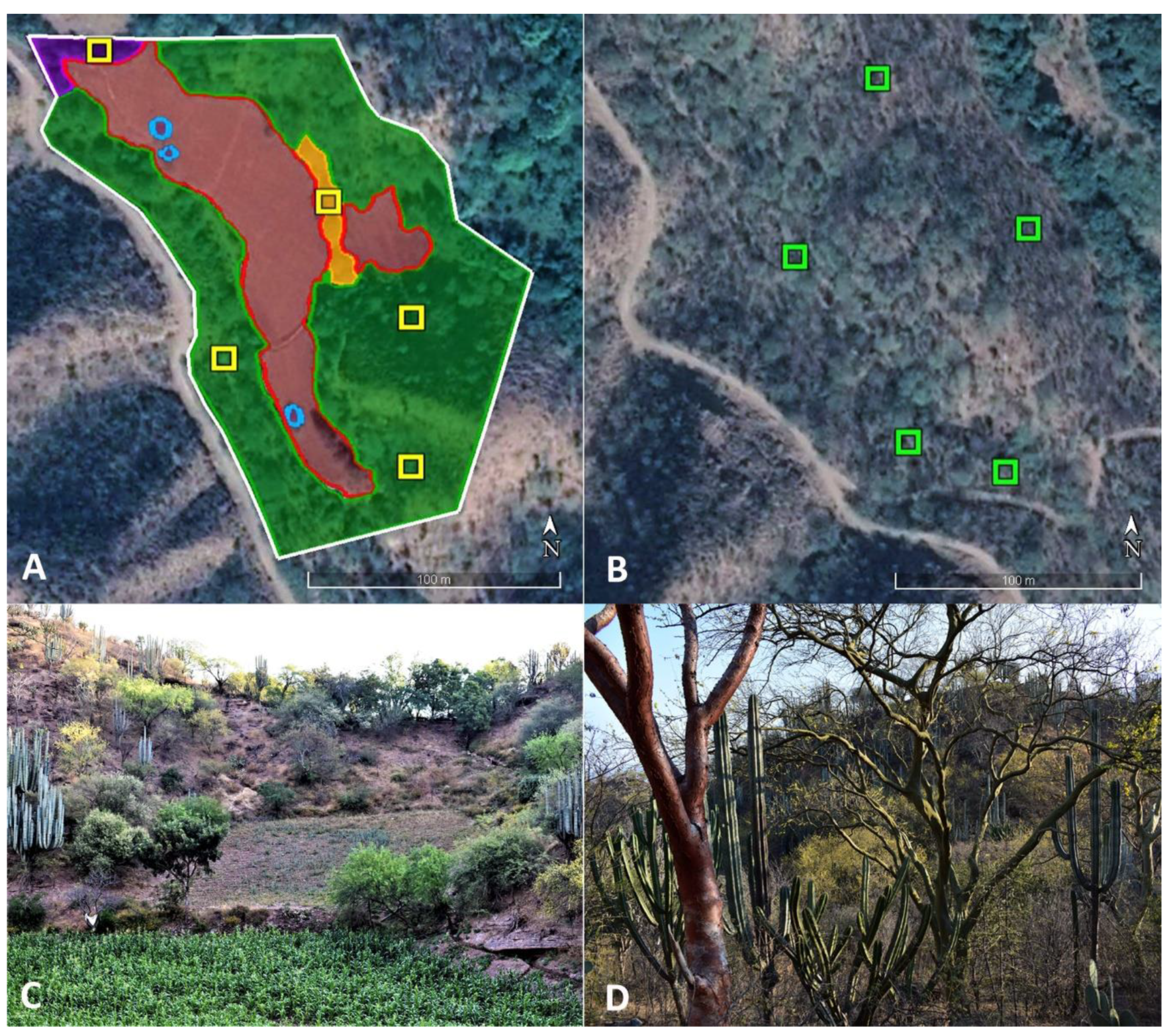
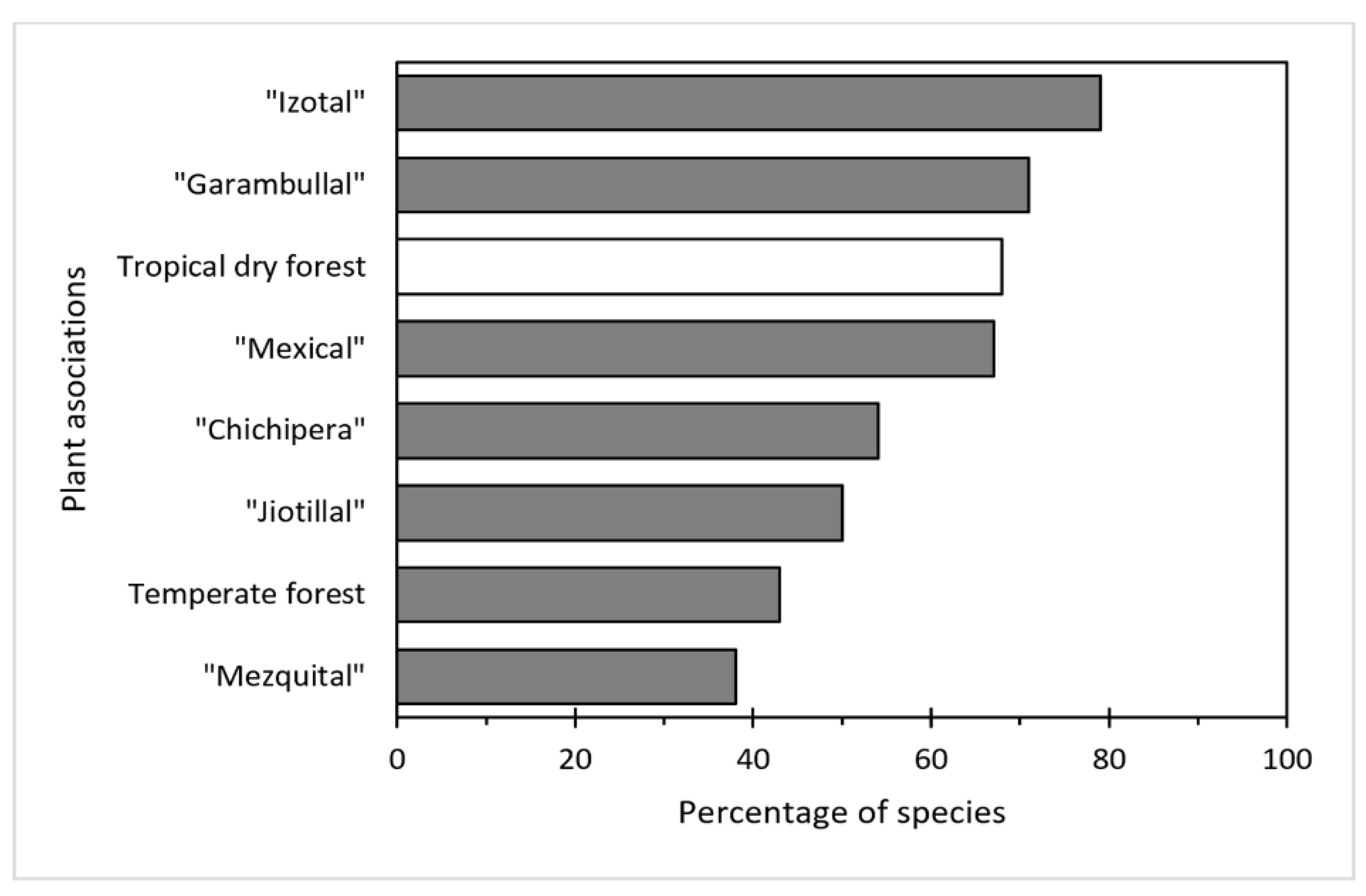
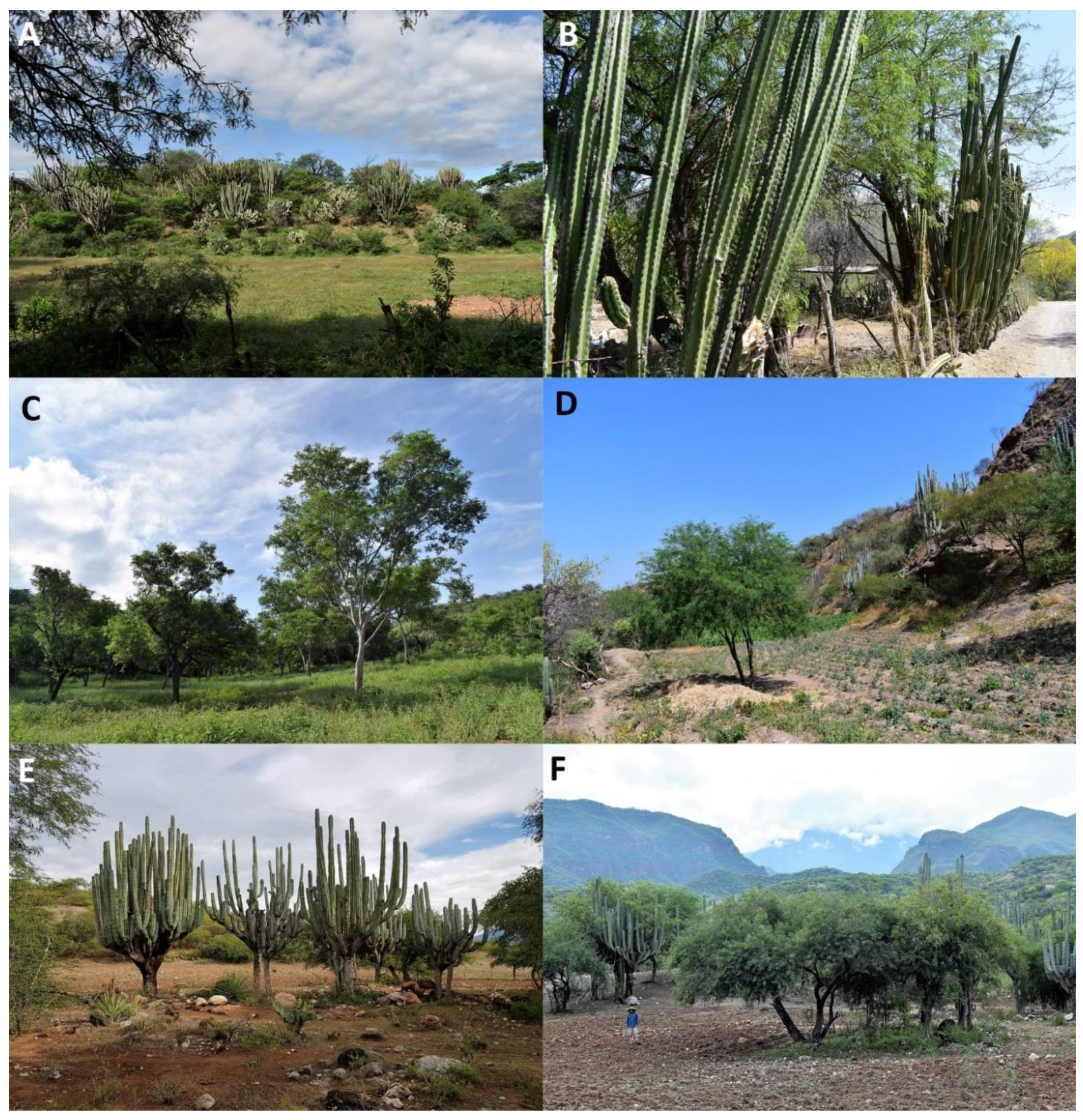
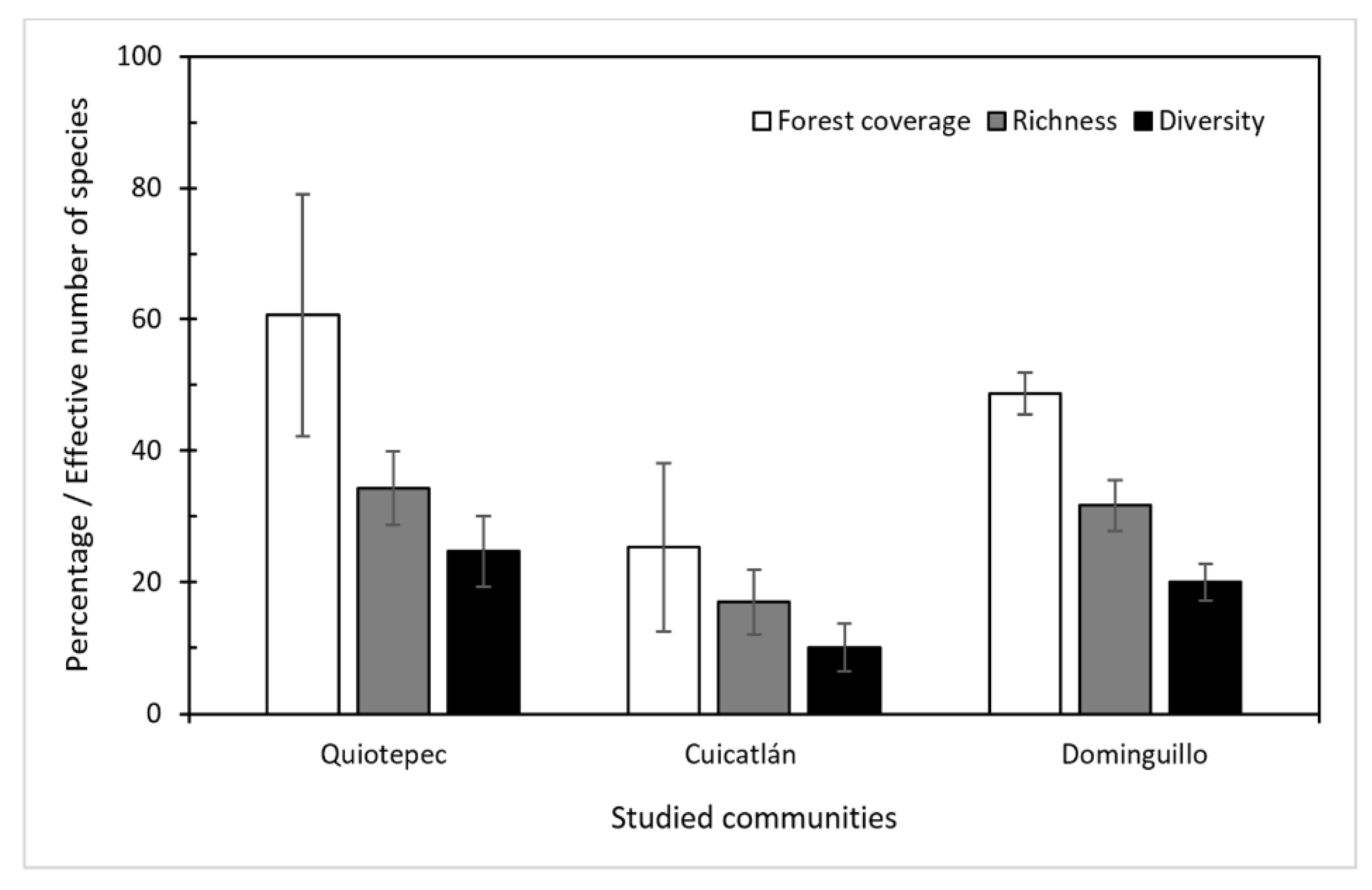
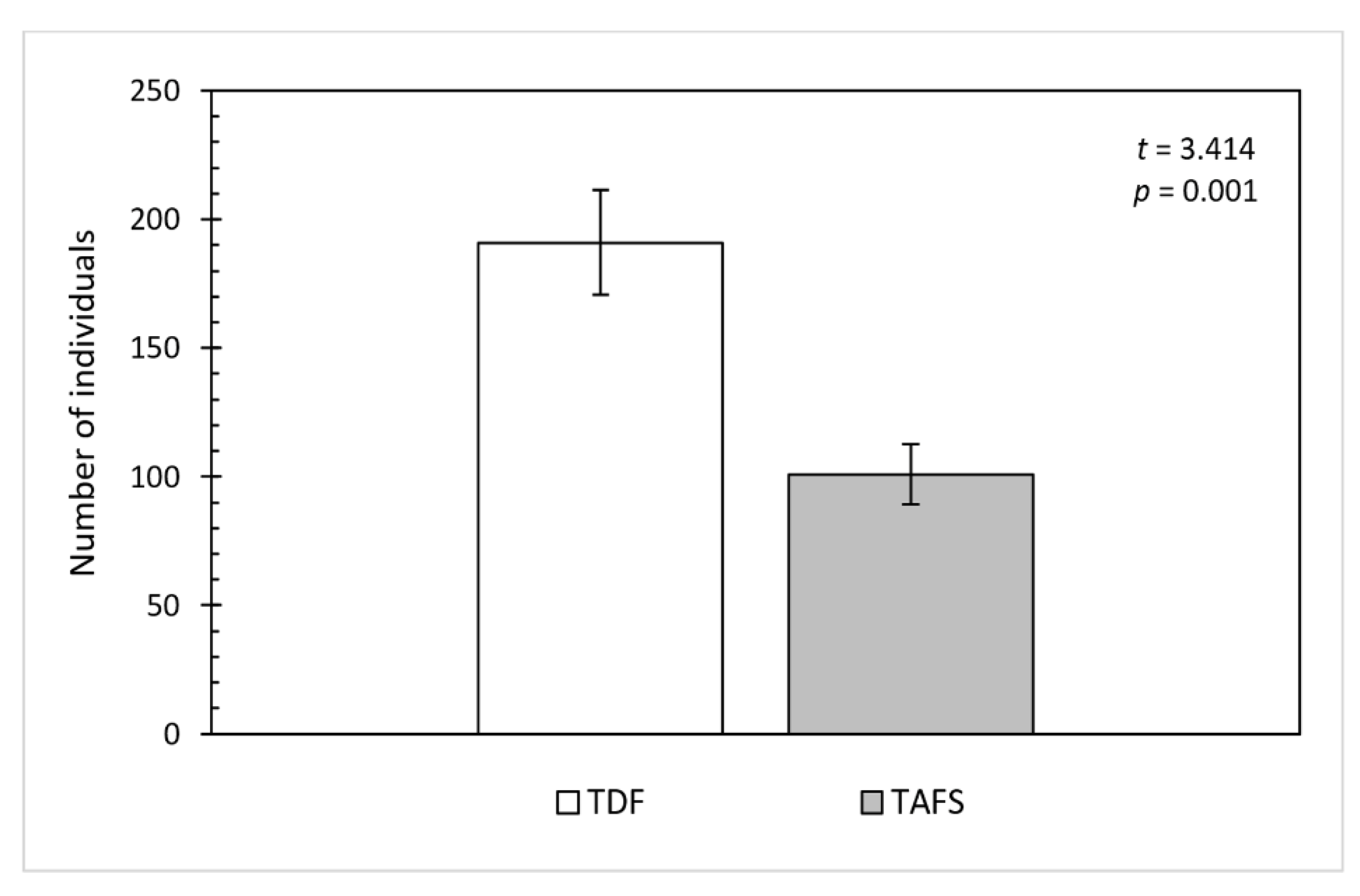
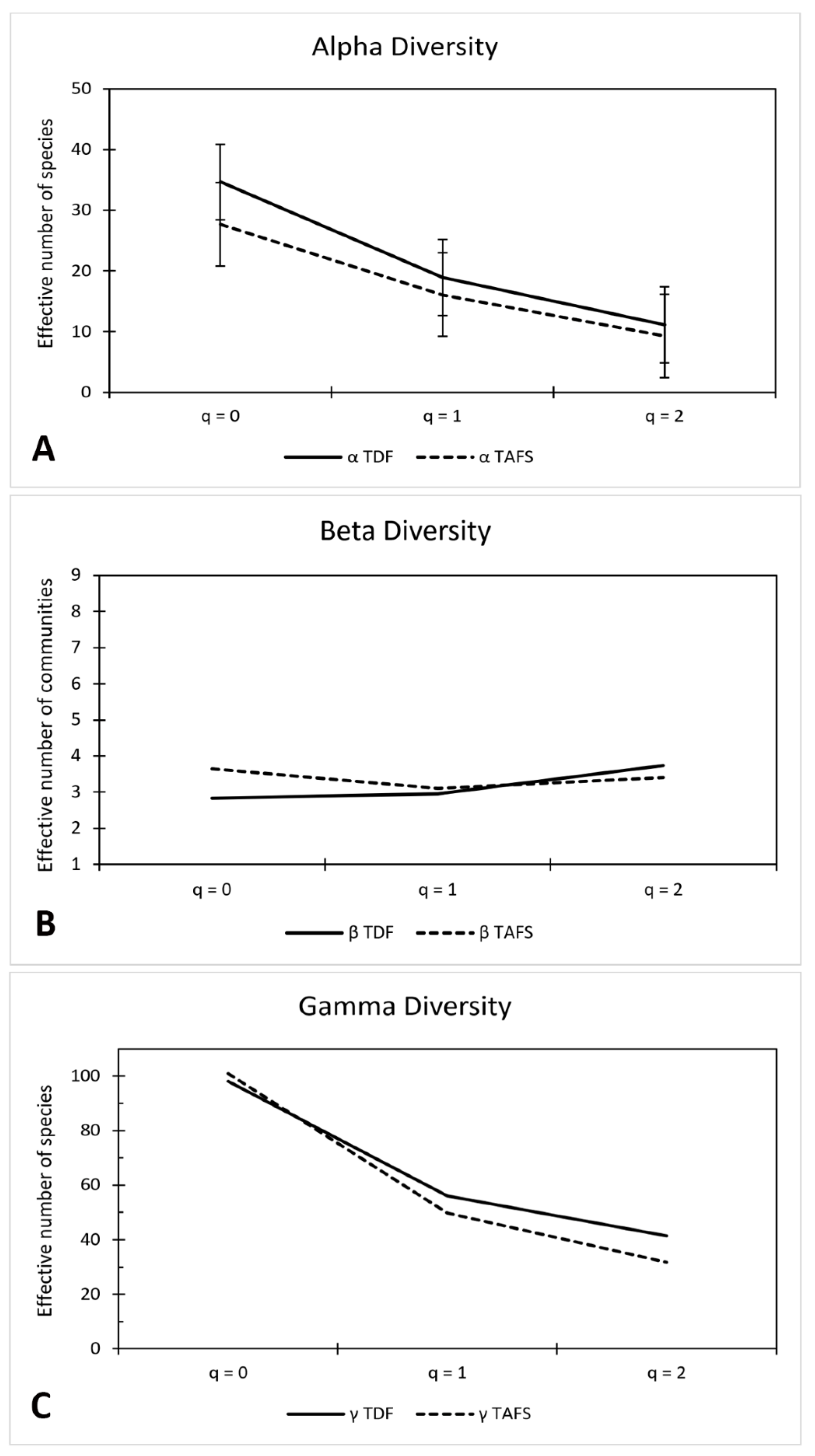
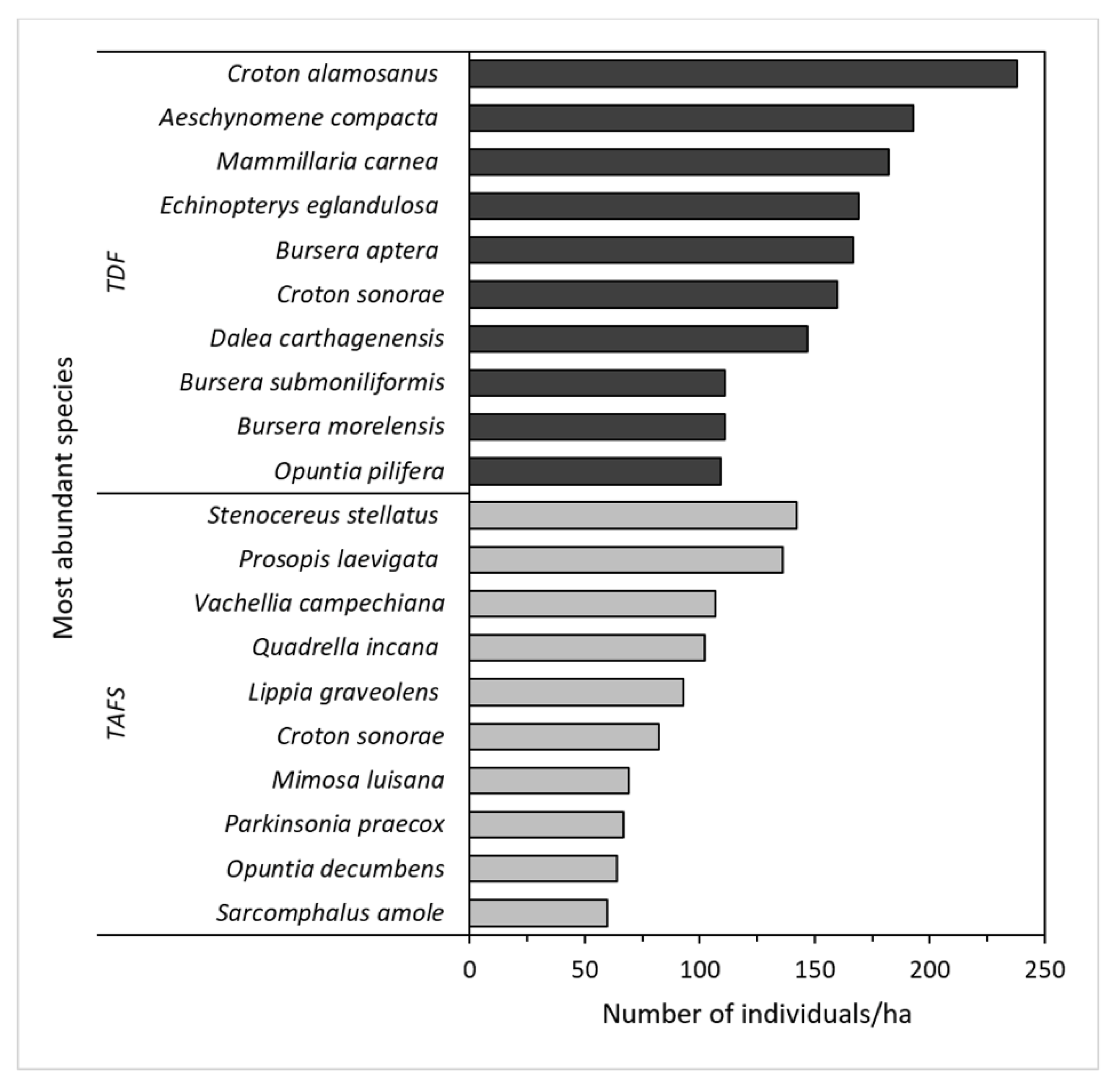
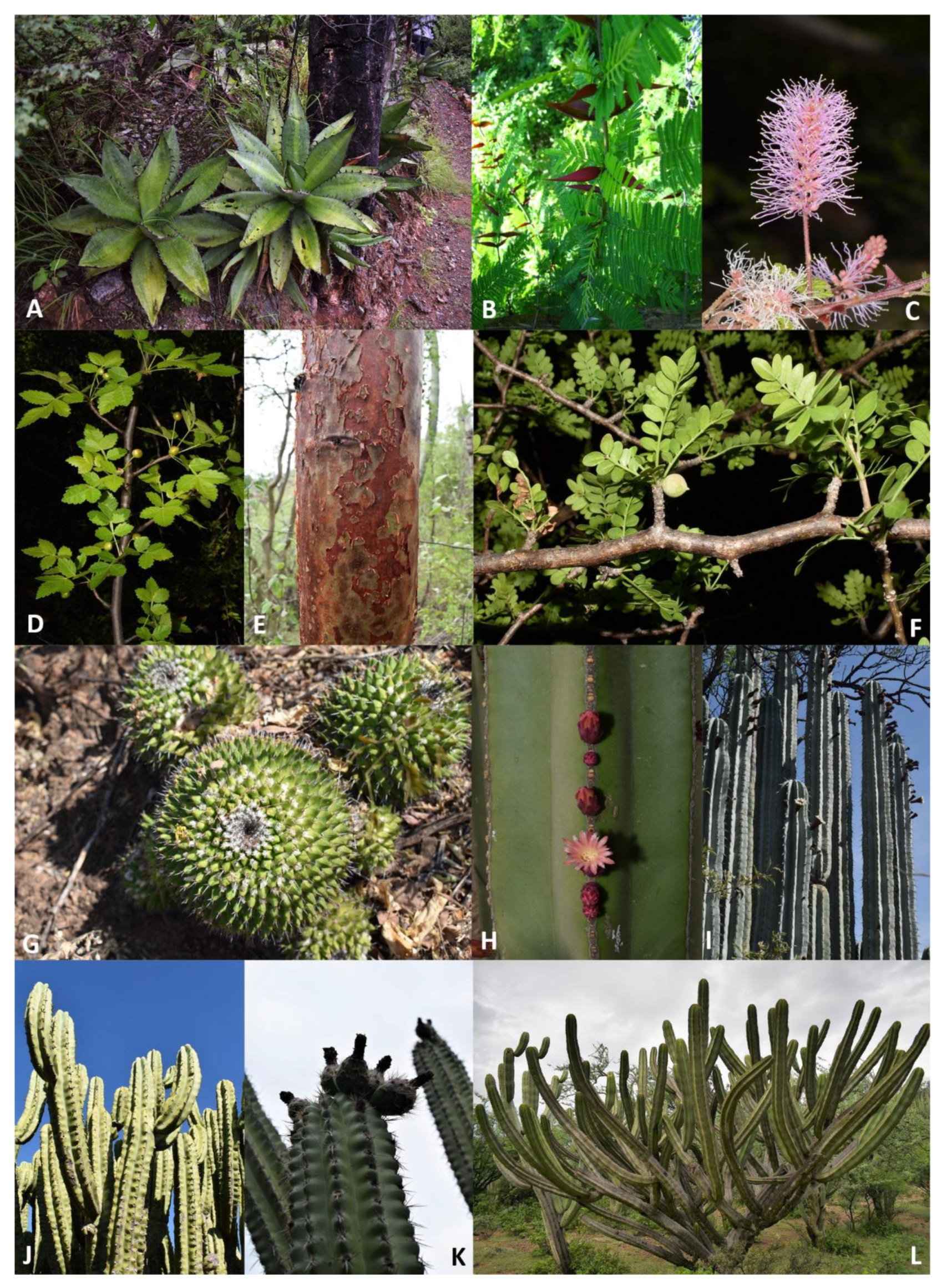
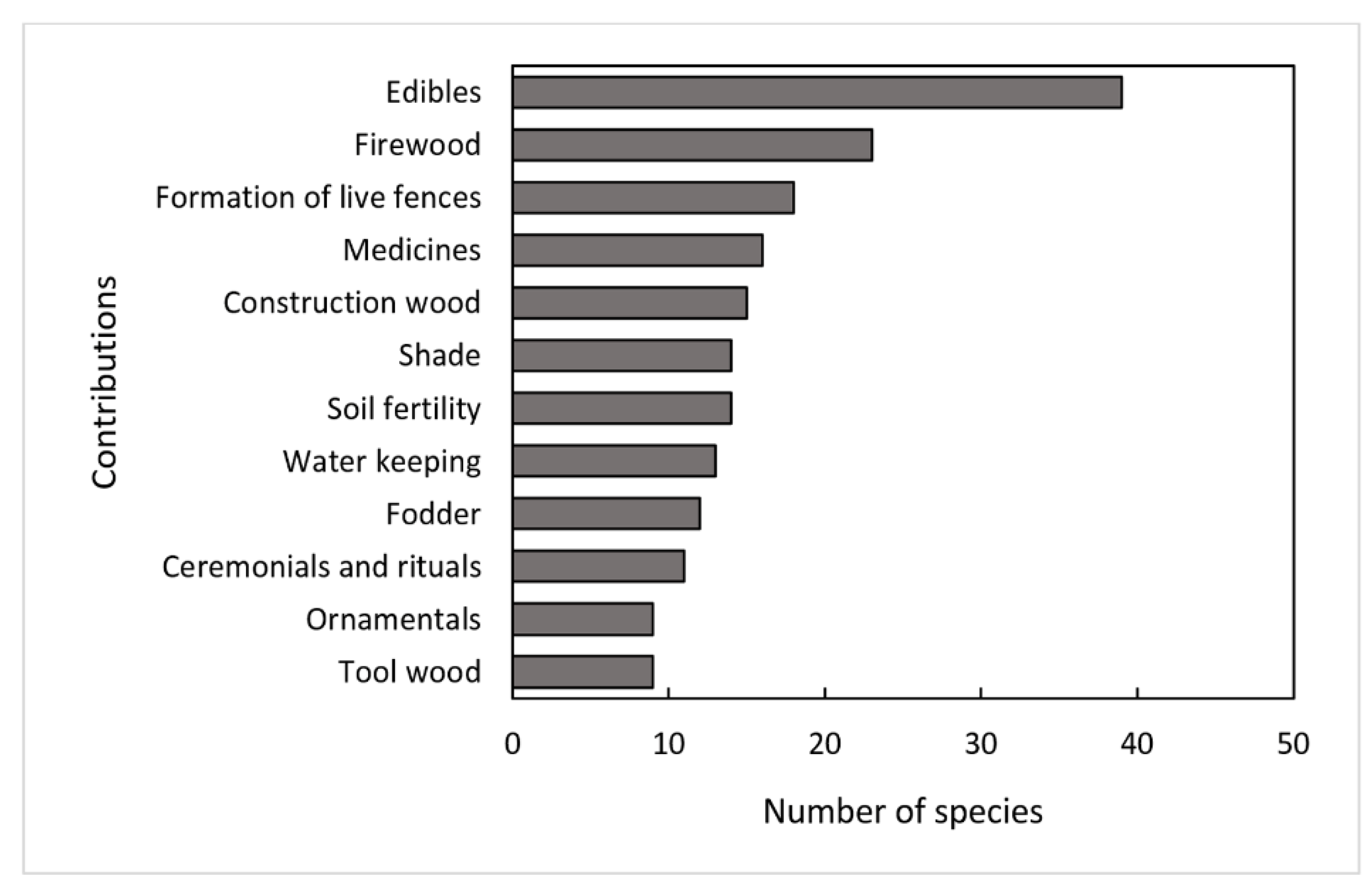
| Sites | Agroforestry Practices Cover in m2 (%) | Surface in ha (%) | |||||||
|---|---|---|---|---|---|---|---|---|---|
| Remnants of Native Vegetation | Live Fences | Forest Cover Patches | Isolated Trees | Vegetation Fringes | Vegetation Islands | Forest Cover | Agricultural Cover | Total | |
| Quiotepec | |||||||||
| Los Chivos | 12,676 (56) | 380 (2) | 1687 (7) | 137 (1) | 1.49 (66) | 0.76 (34) | 2.25 | ||
| La Cañadita | 7373 (52) | 2541 (18) | 2765 (19) | 1.27 (89) | 0.15 (11) | 1.42 | |||
| El Panteón | 588 (9) | 299 (4) | 329 (5) | 572 (8) | 0.18 (26) | 0.51 (74) | 0.69 | ||
| Cuicatlán | |||||||||
| La Cruz | 1459 (12) | 285 (2) | 0.17 (14) | 1.02 (86) | 1.20 | ||||
| Hormiga | 7901 (46) | 482 (3) | 262 (2) | 0.86 (51) | 0.84 (49) | 1.70 | |||
| Rinconada | 1812 (8) | 575 (3) | 80 (0) | 0.25 (11) | 1.97 (89) | 2.22 | |||
| Dominguillo | |||||||||
| Manantial | 7495 (49) | 520 (3) | 141 (1) | 159 (1) | 0.83 (54) | 0.70 (46) | 1.53 | ||
| Abandonada | 5852 (37) | 830 (5) | 96 (1) | 0.68 (43) | 0.89 (57) | 1.57 | |||
| El Tablero | 9472 (40) | 1463 (6) | 540 (2) | 1.15 (48) | 1.24 (52) | 2.38 | |||
| Total | 53,169 (35.54) | 7090 (4.74) | 6451 (4.31) | 1330 (0.89) | 572 (0.38) | 159 (0.11) | 6.88 (45.98) | 8.08 (54.02) | 14.96 (100) |
| Sites | Abundance of Individuals | 0D (Species Richness) | 1D (Typical Species) | 2D (Dominant Species) | Evenness Factor (2D/0D) | Shannon (H´) | Simpson (D) |
|---|---|---|---|---|---|---|---|
| Tropical Dry Forests | |||||||
| Quiotepec | |||||||
| El Mono | 113 | 38 | 27.77 | 22.21 | 0.584 | 3.32 | 0.045 |
| Pitayagrande | 168 | 38 | 26.33 | 20.31 | 0.534 | 3.29 | 0.049 |
| La Roseta | 203 | 33 | 18.71 | 13.68 | 0.415 | 2.93 | 0.073 |
| Cuicatlán | |||||||
| Tabuada | 244 | 37 | 23.20 | 17.24 | 0.466 | 3.14 | 0.058 |
| Plan dos | 182 | 32 | 20.85 | 16.16 | 0.505 | 3.04 | 0.062 |
| Cañada de Marcelino | 248 | 42 | 22.70 | 13.73 | 0.327 | 3.12 | 0.073 |
| Dominguillo | |||||||
| Las Manitas | 139 | 46 | 31.35 | 21.40 | 0.465 | 3.45 | 0.047 |
| Tepalcates | 166 | 24 | 9.02 | 4.99 | 0.208 | 2.20 | 0.200 |
| La Coyotera | 252 | 22 | 7.31 | 4.94 | 0.225 | 1.99 | 0.202 |
| Alpha Diversity (α) | 191 ± 49.93 | 34.67 ± 7.86 | 19.92 ± 8.10 | 11.12 ± 6.44 | 0.321 | 2.95 | 0.090 |
| Gamma Diversity (γ) | 1715 | 98 | 56.03 | 41.50 | 0.423 | 4.05 | 0.024 |
| Traditional Agroforestry Systems (“Apancles”) | |||||||
| Quiotepec | |||||||
| Los Chivos | 87 | 32 | 21.81 | 15.48 | 0.484 | 3.08 | 0.065 |
| La Cañadita | 140 | 45 | 35.23 | 27.76 | 0.617 | 3.56 | 0.036 |
| El Panteón | 83 | 26 | 17.06 | 12.83 | 0.493 | 2.84 | 0.078 |
| Cuicatlán | |||||||
| La Cruz | 26 | 8 | 6.12 | 5.12 | 0.640 | 1.81 | 0.195 |
| Hormiga | 107 | 25 | 17.26 | 13.61 | 0.544 | 2.85 | 0.073 |
| Rinconada | 77 | 18 | 6.85 | 3.30 | 0.183 | 1.92 | 0.303 |
| Dominguillo | |||||||
| Manantial | 130 | 39 | 25.74 | 19.56 | 0.502 | 3.25 | 0.051 |
| Abandonada | 90 | 26 | 17.47 | 12.70 | 0.488 | 2.86 | 0.079 |
| El Tablero | 169 | 30 | 16.85 | 11.20 | 0.373 | 2.82 | 0.089 |
| Alpha Diversity (α) | 101 ± 41.63 | 27.67 ± 10.87 | 16.08 ± 8.94 | 9.29 ± 7.29 | 0.336 | 2.80 | 0.108 |
| Gamma Diversity (γ) | 909 | 101 | 49.89 | 31.71 | 0.314 | 3.94 | 0.032 |
| Families | Genera (%)/Species (%) | Genera | Species (%) |
|---|---|---|---|
| Fabaceae | 14 (13.86)/19 (14.39) | Bursera | 7 (5.30) |
| Cactaceae | 12 (11.88)/18 (13.64) | Opuntia | 6 (4.55) |
| Euphorbiaceae | 6 (5.94)/9 (6.82) | Agave | 4 (3.03) |
| Burseraceae | 1 (0.99)/7 (5.30) | Vachellia | 3 (2.27) |
| Malvaceae | 6 (5.94)/6 (4.55) | Croton | 3 (2.27) |
| Rhamnaceae | 4 (3.96)/5 (3.79) | Mimosa | 3 (2.27) |
| Malpighiaceae | 5 (4.95)/5 (3.79) | Sarcomphalus | 2 (1.52) |
| Verbenaceae | 3 (2.97)/5 (3.79) | Stenocereus | 2 (1.52) |
| Others | 51 (50.50)/58 (43.94) | Others | 101 (77.28) |
| Contributions | Number of Species | Some Outstanding Examples |
|---|---|---|
| Material | ||
| Edible fruits | 23 | columnar cacti |
| Edible stems | 12 | “quelites” (Crotalaria pumila, Porophyllum ruderale), “nopal de cruz” Acanthocereus subinermis |
| Edible flowers | 2 | “cacayas” of “rabo de león” Agave quiotepecensis and “mano de león” Agave seemanniana |
| Edible roots | 1 | “jícama de pochote” Ceiba parvifolia |
| Firewood | 23 | Fabaceae |
| Formation of live fences | 18 | Cactaceae, Burseraceae, Fabaceae, Rhamnaceae |
| Medicines | 16 | “cuachalalá” Amphipterygium adstringens (healing), “oreganillo” Lippia graveolens (digestive) |
| Construction wood | 15 | “mezquite” Prosopis laevigata, “quebracho” Vachellia pringlei |
| Fodder | 12 | Fabaceae (tender fruits), “caulote” Guazuma ulmifolia |
| Tool wood | 9 | “agalán” Karwinskia humboldtiana, “palo prieto” Krugiodendron ferreum, “matagallina” Quadrella incana |
| Beverage preparation | 5 | “cardón” Pachycereus weberi (“pulque rojo”), others columnar cacti, “chupandía” Cyrtocarpa procera |
| Thirst quencher | 1 | fruit of “biznaga” Ferocactus latispinus var. spiralis |
| Resins | 1 | “linaloe” Bursera linanoe |
| Saponifers | 1 | “cholulo” Sarcomphalus pedunculatus |
| Poisons | 1 | “brea” Bursera aptera |
| Regulating | ||
| Shade | 14 | “mezquite” Prosopis laevigata, “guamúchil” Pithecellobium dulce |
| Soil fertility | 14 | “chimalacate” Viguiera dentata, Fabaceae |
| Water keeping | 13 | “mezquite” Prosopis laevigata, “palo de agua” Astianthus viminalis |
| Protect soil from erosion | 6 | Agave spp., Hechtia spp., Opuntia spp. |
| Pest control | 1 | “venenillo” Cascabela thevetia (versus the ant “chicatana” Atta mexicana) |
| Habitat of other useful species | 1 | “mantecoso” Parkinsonia praecox (host of the mushroom “nanacate” Schizophyllum commune) |
| Rainfall attraction | “all the trees on the hill call the water” | |
| Nonmaterial | ||
| Ceremonials and rituals | 11 | “copales” and “cuajiotes” of genus Bursera |
| Ornamentals | 9 | “huesito” Plocosperma buxifolium, “solterito” Petrea volubilis |
| “They have a right to life” | “all plants” |
© 2020 by the authors. Licensee MDPI, Basel, Switzerland. This article is an open access article distributed under the terms and conditions of the Creative Commons Attribution (CC BY) license (http://creativecommons.org/licenses/by/4.0/).
Share and Cite
Rendón-Sandoval, F.J.; Casas, A.; Moreno-Calles, A.I.; Torres-García, I.; García-Frapolli, E. Traditional Agroforestry Systems and Conservation of Native Plant Diversity of Seasonally Dry Tropical Forests. Sustainability 2020, 12, 4600. https://doi.org/10.3390/su12114600
Rendón-Sandoval FJ, Casas A, Moreno-Calles AI, Torres-García I, García-Frapolli E. Traditional Agroforestry Systems and Conservation of Native Plant Diversity of Seasonally Dry Tropical Forests. Sustainability. 2020; 12(11):4600. https://doi.org/10.3390/su12114600
Chicago/Turabian StyleRendón-Sandoval, Francisco J., Alejandro Casas, Ana I. Moreno-Calles, Ignacio Torres-García, and Eduardo García-Frapolli. 2020. "Traditional Agroforestry Systems and Conservation of Native Plant Diversity of Seasonally Dry Tropical Forests" Sustainability 12, no. 11: 4600. https://doi.org/10.3390/su12114600
APA StyleRendón-Sandoval, F. J., Casas, A., Moreno-Calles, A. I., Torres-García, I., & García-Frapolli, E. (2020). Traditional Agroforestry Systems and Conservation of Native Plant Diversity of Seasonally Dry Tropical Forests. Sustainability, 12(11), 4600. https://doi.org/10.3390/su12114600







